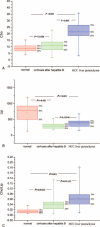1H Magnetic Resonance Spectroscopy Predicts Hepatocellular Carcinoma in a Subset of Patients With Liver Cirrhosis: A Randomized Trial
- PMID: 26166077
- PMCID: PMC4504652
- DOI: 10.1097/MD.0000000000001066
1H Magnetic Resonance Spectroscopy Predicts Hepatocellular Carcinoma in a Subset of Patients With Liver Cirrhosis: A Randomized Trial
Abstract
The goal of this study was to investigate the utility of H magnetic resonance spectroscopy (H-MRS) to quantify the differences in liver metabolites. Magnetic resonance spectroscopy was used as a means of predicting the probability of developing hepatocellular carcinoma (HCC) in patients with liver cirrhosis secondary to chronic hepatitis B.This study included 20 healthy volunteers, 20 patients with liver cirrhosis secondary to chronic hepatitis B (cirrhosis group), and 20 patients with small HCC secondary to cirrhosis liver parenchyma (HCC group). All patients underwent routine MRI and H-MRS scanning. LCModel software was used to quantify Cho (Choline), Lip (lipid), and Cho/Lip in the 3 groups, and a one-way ANOVA was used to compare the differences in these metabolites between groups.Choline levels were significantly different between the control and HCC group and between the cirrhosis group and the HCC group (all P < 0.001). There was also a significant difference in Lip levels between the control and cirrhosis group and the control and HCC groups (all P < 0.001). There were also differences in Cho/Lip between the control and cirrhosis groups, the control and HCC groups, and the cirrhosis and HCC groups (all P < 0.001).H-MRS followed by the analysis with LCModel can be used to measure changes in hepatic metabolite levels in patients with liver cirrhosis secondary to chronic hepatitis B and HCC. Thus, H-MRS may be helpful in monitoring HCC and liver cirrhosis development.
Conflict of interest statement
The authors have no conflicts of interest to disclose.
Figures




Similar articles
-
Virological suppression does not prevent the development of hepatocellular carcinoma in HBeAg-negative chronic hepatitis B patients with cirrhosis receiving oral antiviral(s) starting with lamivudine monotherapy: results of the nationwide HEPNET. Greece cohort study.Gut. 2011 Aug;60(8):1109-16. doi: 10.1136/gut.2010.221846. Epub 2011 Jan 26. Gut. 2011. PMID: 21270118 Clinical Trial.
-
[Small hepatocellular carcinoma in patients with hepatitis B-induced cirrhosis: a comparison between MRI and MDCT].Beijing Da Xue Xue Bao Yi Xue Ban. 2010 Dec 18;42(6):767-72. Beijing Da Xue Xue Bao Yi Xue Ban. 2010. PMID: 21170112 Chinese.
-
Clinical and pathological factors associated with the development of hepatocellular carcinoma in patients with hepatitis virus-related cirrhosis: a long-term follow-up study.Clin Oncol (R Coll Radiol). 2007 Apr;19(3):197-203. doi: 10.1016/j.clon.2006.12.005. Epub 2007 Jan 18. Clin Oncol (R Coll Radiol). 2007. PMID: 17359907
-
Viral hepatitis and hepatocellular carcinoma.Arch Med Res. 2007 Aug;38(6):612-20. doi: 10.1016/j.arcmed.2006.09.004. Arch Med Res. 2007. PMID: 17613352 Review.
-
Hepatocellular carcinoma and other liver lesions.Med Clin North Am. 2014 Jan;98(1):103-18. doi: 10.1016/j.mcna.2013.09.003. Epub 2013 Oct 18. Med Clin North Am. 2014. PMID: 24266917 Review.
Cited by
-
Application of Single Voxel 1H Magnetic Resonance Spectroscopy in Hepatic Benign and Malignant Lesions.Med Sci Monit. 2016 Dec 19;22:5003-5010. doi: 10.12659/msm.902177. Med Sci Monit. 2016. PMID: 27992399 Free PMC article.
-
Hepatocellular carcinoma: State of the art diagnostic imaging.World J Radiol. 2023 Mar 28;15(3):56-68. doi: 10.4329/wjr.v15.i3.56. World J Radiol. 2023. PMID: 37035828 Free PMC article. Review.
-
Imaging evaluation of sorafenib for treatment of advanced hepatocellular carcinoma.Chin J Cancer Res. 2018 Jun;30(3):382-394. doi: 10.21147/j.issn.1000-9604.2018.03.10. Chin J Cancer Res. 2018. PMID: 30046232 Free PMC article.
-
Proton Magnetic Resonance Spectroscopy at 3.0T in Rabbit With VX2 Liver Cancer: Diagnostic Efficacy and Correlations With Tumor Size.Front Oncol. 2022 Mar 31;12:846308. doi: 10.3389/fonc.2022.846308. eCollection 2022. Front Oncol. 2022. PMID: 35433458 Free PMC article.
-
Magnetic resonance imaging for characterization of hepatocellular carcinoma metabolism.Front Physiol. 2022 Dec 15;13:1056511. doi: 10.3389/fphys.2022.1056511. eCollection 2022. Front Physiol. 2022. PMID: 36589457 Free PMC article. Review.
References
-
- Perman WH, Balci NC, Akduman I. Review of magnetic resonance spectroscopy in the liver and the pancreas. Top Magn Reson Imaging 2009; 20:89–97. - PubMed
-
- Wong VW, Wong GL, Yeung DK, et al. Incidence of non-alcoholic fatty liver disease in Hong Kong: a population study with paired proton-magnetic resonance spectroscopy. J Hepatol 2014; 62:182–189. - PubMed
-
- Cuthbertson DJ, Weickert MO, Lythgoe D, et al. External validation of the fatty liver index and lipid accumulation product indices, using 1H-magnetic resonance spectroscopy, to identify hepatic steatosis in healthy controls and obese, insulin-resistant individuals. Eur J Endocrinol 2014; 171:561–569. - PubMed
-
- Cheung JS, Fan SJ, Gao DS, et al. In vivo lipid profiling using proton magnetic resonance spectroscopy in an experimental liver fibrosis model. Acad Radiol 2011; 18:377–383. - PubMed
Publication types
MeSH terms
Substances
LinkOut - more resources
Full Text Sources
Medical

